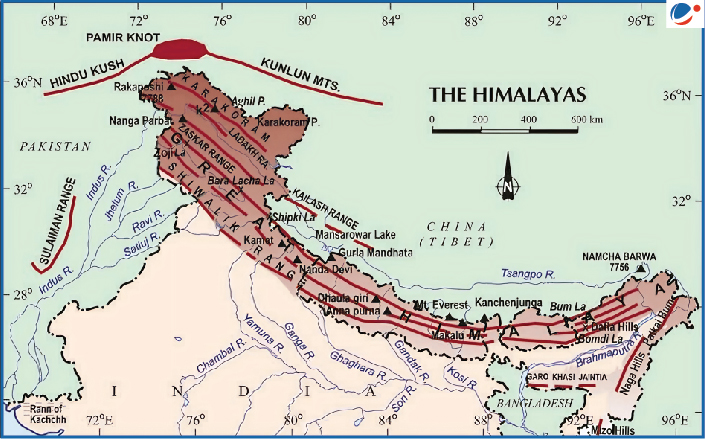Why in the News?
In view of some of the recent judgments of the Supreme Court, the new fundamental right to be free from climate change impact necessitates a sustainable development model for the Indian Himalayan Region (IHR).
More on the News
- In MK Ranjitsinh vs. Union of India case (2024), Supreme Court recognized the right to be free from the adverse effects of climate change under Articles 14 and 21 of the Indian Constitution.
- In Ashok Kumar Raghav vs Union of India case (2023), Supreme Court asked the central government and the petitioner to suggest a way forward so as to enable the Court to pass directions on the carrying capacity of the Himalayan States and towns for sustainable development.
- Carrying capacity is the maximum population size that an ecosystem can sustain without getting degraded.
- In State of Telangana vs Mohd. Abdul Qasim case, the Court had said that the need of the hour is to adopt an ecocentric view of the environment (where nature is at the core).
- Aspirations for growth and development in the Indian Himalayan Region need to be aligned with science and the rights of people and nature.
About Indian Himalayan Region (IHR)
 |
Importance of IHR
- Drainage and Water Resources: The region is known as a 'water tower of the earth'.
- The glaciers in the Himalaya feed majority of rivers (like Ganga, Yamuna, Indus, and Brahmaputra) supporting livelihood for about 1.4 billion people whose very survival depends on glacial fed rivers.
- Ecosystem Services: It is the source of many ecosystem goods, such as food, medicine and genetic resources, and services like Carbon Sequestration, water regulation etc.
- Regulating the climate: By preventing frigid, dry arctic winds blowing south into the subcontinent.
- It also forms a barrier for the monsoon winds, keeping them from traveling northwards, and causing rainfall in the south of the Himalaya.
- Tourism: The high-altitude lakes, mountain peaks and sacred natural sites attract tourists and have a vast potential of eco-tourism, adventure tourism and religious tourism (like Amarnath, Badrinath etc).
Challenges associated with IHR
- Unsustainable development: Deforestation due to agriculture, obstruction of natural flow of water due to construction of various mega hydel Power Projects (like Tehri Dam), mining and blasting of mountains (for e.g., Char Dham Project) etc. increased incidents of disaster.
- For e.g., in 2023, Sinking of Joshimath in Uttarakhand, floods and landslides in Himachal Pradesh, a glacial lake outburst in Sikkim, Silkyara-Barkot tunnel in Uttarkashi etc.
- Rising Tourism: IHR records about 100 million tourists every year and the number are expected to increase to 240 million by 2025, putting huge pressure on resources.
- As per NITI Aayog, Tourism contributes more than 10% of the Gross State Domestic Product (GSDP) in many states such as Uttarakhand, West Bengal, Tripura, Assam, etc.
- Impact of Climate Change: ISRO satellite imagery has revealed that glaciers across the Indian Himalayan region have been melting at alarming rates, leading to the significant expansion of glacial lakes.
- This increases the threat of glacial lake outburst floods multifold.
- Water Crisis: According to estimates, out of 4 million springs in the Himalayas, at least 33% are drying up and more than 50% have witnessed decline in water discharge.
- For e.g., The water problems of Shimla and other hill towns in India are a direct result of drying of spring.
- Flaw in Environment Clearance System: Despite all levels of government being acutely aware of the special needs of the IHR, the region's vulnerabilities and fragility have not been considered separately.

Way Forward
- Integrated development: Establish a "Himalayan Authority" to coordinate integrated and holistic development of the Himalayan States, ensure synergy, provide strategic guidance, and monitoring SDGs fulfillment.
- Sustainable Tourism: Need Business plans for "Smart Mountain Tourism Destinations" on the lines of Smart Cities, introduce 'Green Cess' (Payment for Environmental Services) based on eco-certification, etc.
- Improve Water Security: Building on best practices, (e.g., Dhara Vikas in Sikkim and others) for revival of springs where water quantity and quality has deteriorated.
- Capacity building: Research needs to be strengthened is in blending traditional knowledge on resource use and management with modern scientific approaches.
- Improve Clearance System: Indian Himalayan Region needs its own Environment Impact Assessment (EIA).
- EIA is a tool to identify the environmental, social, and economic impacts of a project before it is implemented.



